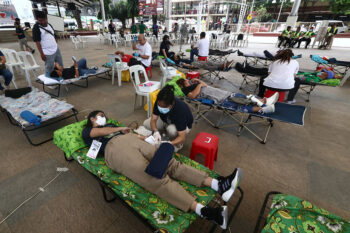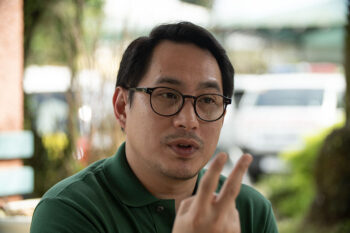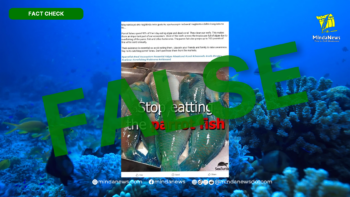II. On the DAP
GENERAL SANTOS CITY (MindaNews/16 November)–The concepts underlying the SPF, PSF and PDAF are good. However, presidents and leaders in the Congress have tampered the concepts to promote political patronage and trade-off for their political and private interests.
Clarification
The critics do not question President Aquino’s honesty in spending government funds under his control; they do not question the benefits derived from the PSF and the DAP. The issues they have raised are on the constitutionality and legality of the PSF and the DAP – more especially of the latter – and some improprieties in the conduct of the President in relation to some members of the Congress. They do not label the President as “thief”; yet, this is the malicious implication that hurts most and which to the President, the Palace and his loyal supporters is the main issue.
Seen from another angle, the “daang matuwid” (straight path) is under attack. While this is seen by the President and the Palace as the impeccable way of reforms, it should be asked after three years: Is daang matuwid concerned only with the corruption of public funds and other forms of abuses in the government? Is it “daang matuwid” to tolerate or engender in governance the false principle of “the end justifies the means” and other moral infirmities?
The controversies are about what critics see as deviations from “daang matuwid”.
Creation of the DAP
Conceptualized in September 2011 as “a stimulus package … designed to fast-track public spending and push economic growth”, the “DAP was approved … on October 12, 2011 upon the recommendation of the Development Budget Coordination Committee and the Cabinet Cluster.” (The Official Gazette, October 7, 2013: Q&A on the Disbursement Acceleration Program).
As explained by the Department of Budget in its “Q&A” and another item, “Constitutional and legal bases for the Disbursement Acceleration Program”, published in The Official Gazette, October 5, 2013, the DAP is constitutional and legal and so are its sources of funds – citing the 1987 Constitution, the 1987 Administrative Code, and general provisions on the use of savings in the General Appropriation Acts of 2011, 2012 and 2013 – and it has generated tremendous economic and social benefits for the country.
The controversy over the DAP is rooted in the constitutionality and legality of its creation and in the sources and disbursement of its funds. These will be the focus of the oral arguments when the nine petitions against the DAP are heard at the Supreme Court on November 19. It is, however, enlightening to take a look at some details about the sources and disbursement of DAP funds as well as the benefits as explained by the two DBM items in The Official Gazette cited above.
Sources of Funds
The first source is savings; the second, unprogrammed funds which include “unexpected remittance of dividends from the GOCCs and Government Financial Institutions (GFIs), sale of government assets” as well as “loans for foreign-assisted projects”.
As provided in the 2011, 2012 and 2013 GAAs: “Savings refer to portions or balances of any programmed appropriation in [these Acts] free from any obligation or encumbrance that are:
“(i) still available after the completion or final discontinuance or abandonment of the work, activity or purpose for which the appropriation is authorized;
“(ii) from appropriations balances arising from unpaid compensation and related costs pertaining to vacant positions and leaves of absence without pay; and
“(iii) from appropriations balances realized from the implementation of measures resulting in improved systems and efficiencies and thus enabled agencies to meet and deliver the required or planned targets, programs and services approved in [these Acts] at a lesser cost.
The GAAs define “augmentation” in reference to the “use of savings” as provided in the 1987 Constitution: “Augmentation implies the existence in [these Acts] of a program, activity or project with an appropriation, which upon implementation, or subsequent evaluation of needed resources, it is determined to be deficient. In no case shall a non-existent program, activity or project be funded by augmentation from savings or by the use of appropriations otherwise authorized in [these Acts].” Note: What and what not to augment are clear.
As also provided in the 2011, 2012 and 2013 GAAs: “Unprogrammed Funds are standby appropriations authorized by Congress in the annual general appropriations act which may be availed only when any of the following instances occur:
“i. revenue collections exceed the original revenue targets in the Budget of Expenditures and Sources of Financing (BESF) submitted by the President to Congress;
“ii. new revenues are collected/realized from sources not originally considered in the BESF submitted by the President to Congress; or
“iii. newly-approved loans for foreign-assisted projects are secured or when conditions are triggered for other sources of funds such as perfected loan agreements for foreign assisted projects.”
The instances above are the conditions for the availability and release of the unprogrammed funds. However, while GAA 2013 requires the certification by the Bureau of Treasury of the veracity of (i) and (ii), GAAs 2011 and 2012 did not. GAA 2013 – so did the two other GAAs — provides that in case of (iii), “the existence of a perfected loan agreement for the purpose shall be sufficient basis for the issuance of a SARO covering the loan proceeds”.
Releases and Disbursements
Without specifying the amounts as to sources – whether “savings” or “unprogrammed funds”, the DBM revealed (Q&A on DAP):
(1) For 2011-2012, a total of P142.23 Billion was released for programs and projects identified through the DAP — P83.53 Billion for 2011 and 58.70 Billion for 2012. In 2011, the amount was used to provide additional funds for programs/projects such as healthcare, public works, housing and resettlement, and agriculture, among others. While in 2012, these were used to augment tourism road infrastructure, school infrastructure, rehabilitation and extension of light rail transit systems, and sitio electrification, among others.
(2) In 2013, about P15.13 Billion has been approved for the hiring of policemen, additional funds for the modernization of PNP, the redevelopment of Roxas Boulevard, and funding for the 7 Typhoon Pablo rehabilitation projects for Compostela Valley and Davao Oriental.
(3) Programs and projects funded through DAP: DBM October 28, 2011: P1.97 billion for day care, nutrition, livelihood, and shelters in ARMM; DBM December 13, 2011: 85% of P72-B disbursement acceleration plan already released; DBM January 9, 2012: 96% of P72.11-B disbursement acceleration already released, 77.5% disbursed; DPWH February 10, 2012: DPWH off to strong start in 2012
Impact of the DAP
According to DBM(Q&A on DAP): “Before the DAP was introduced in October 2011, national government disbursements from January to September shrank by 7 percent year on year and was below program by 16 percent. Because of DAP and other measures (e.g., Catch-up plans of departments/agencies, among others), public spending in the fourth quarter of 2011 grew year-on-year by a whopping 32.5 percent and was above program by 11.8 percent. As an effect, the year-on-year growth of disbursements for the whole 2011 was pushed up to 2.3 percent; similarly the level of underspending against program was reduced to 9 percent.
“DAP not only helped push GDP growth; services funded through DAP—such as transport, tourism and agriculture infrastructure—also supported more economic activity. In addition, the DAP expanded the delivery of key services to the people, such as the provision of healthcare services and the construction of school buildings. More important, programs and projects funded through DAP supported the administration’s socioeconomic development agenda, as outlined in President Aquino’s Social Contract with the Filipino people.
The increased growth and reduction of underspending for the whole 2011 is the impact of the P83.53 billion released through the DAP in the last quarter of 2011. This was expected after the President had reduced spending on project implementation during the first three quarters of 2011 and the last two quarters of 2010.
Criteria for Funding
Programs and projects may be submitted to the DBM for DAP funding if they meet the following criteria (Q&A on DAP):
(1) “Fast-moving or quick-disbursing, e.g. the payment of obligations incurred from premium subsidy for indigent families in the National Health Insurance Program;
(2) “Urgent or priority in terms of social and economic development objectives, e.g. the upgrading of equipment and facilities for specialty hospitals, rehabilitation of Light Rail Transit and Metro Rail Transit, and the Disaster Risk and Exposure Assessment for Mitigation (DREAM) program of DOST;
(3) “Programs or projects performing well and could deliver more services to the public with the additional funds e.g. Training for Work Scholarship Program of DOLE-TESDA.
(4) “Some of the items funded through the DAP are expenditures which are mandated by law, such as capital infusion for the Bangko Sentral ng Pilipinas (R.A. 7653, Section 2) out of the augmented Budgetary Support to Government Corporations-Others.”
Under the above criteria, “legislators have also endorsed programs and projects for the social and economic benefit of their constituents, such as medical assistance and local infrastructure projects”. Of the P142.23 billion DAP funds for 2011-2012 “only 9 percent [P12.8 billion] was released to programs and projects identified by legislators. These were not released directly to legislators but to implementing agencies.” (Q&A on DAP)
Questioned
The DAP has been questioned by critics as not authorized in the GAAs. As the Philippine Daily Inquirer has reported (October 31, 2013: Aquino may be going out on a limb over pork issue, say critics), Navotas Rep. Tobias Tiangco criticized President Aquiino for trying to “defend the indefensible”, referring to the President’s October 30 prime time television address defending the DAP.
Tiangco, secretary general of Vice President Jejomar Binay’s United Nationalist Alliance, said: “The question is simple: Is there DAP in the 2014 budget? If there’s no DAP in the national budget, then it means it’s illegal, no matter how you try to justify it, even if you claim that the money was spent for the public good.
“The President can’t just pool these so-called savings and spend them where he wants to without the knowledge of Congress. That’s the issue. And it cannot be justified.”
As seen in the DBM’s “Q&A on the DAP”, the Budget Secretary and his staff conceptualized it and the President approved it as recommended by the DBCC and the Cluster Cabinet. Pertinent provisions of the 1987 Constitution, the existing GAAs and the 1987 Administrative Code were adopted for the legality and constitutionality of its creation, funding and operation. No known executive order created it. As a significant reform in fiscal management for the implementation of government projects, the Congress should have created it by law.
Senator Miriam Defensor-Santiago is among those who, contrary to what the President and the Budget Secretary think, contend that the “savings” funding the DAP are not all savings. Only funds in excess of the appropriation after the completion of the projects are savings. Defunding slow-moving or still-to-be implemented projects is illegal, she said.
Tiangco’s and Santiago’s questions are among the six issues on the DAP to be tackled during oral arguments at the Supreme Court on November 19: (1) the real nature of the DAP — whether it’s a fund or a program; (2) the legal basis for the creation of the DAP; (3) the constitutionality of the DAP based on fund releases upon requests of specific legislators; (4) the definition of “savings” as used in the Constitution and relevant issuances; (5) the legality of the DAP as a program based on existing laws; (6) the constitutionality of the use of DAP funds to augment GAA appropriations. (Rappler.com)
DAP and “Daang Matuwid”
“Daang matuwid” is not just a slogan but, from what the President and the Palace have said, a vision of a path of governance opposite that of any crooked, corrupt government. It is straight without detours and at the same time solid without holes. All road signs are reminders of moral integrity. Does the DAP follow or does it deviate from “daang matuwid”?
First, created neither by an executive order nor by the Congress, DAP operates according to the discretion of the President. It had been kept from the public almost two years after its approval.
Second, can project and service funds be augmented without the DAP? It had been done before as provided in the GAA and the Code. But through the DAP, the President has more discretion.
Third, the 1987 Administrative Code enumerates thirteen purposes or uses of savings provided in the GAA. Through the DAP, the President has more discretion in the use and disbursement of savings. As gleaned from the DBM “Q&A on the DAP”, it appeared that some disbursements were for new funding, not just augmentation.
Fourth, “Únprogrammed Fund” is Category 2 of the Special Purpose Fund in the GAA. The GAA appropriates these according to specific purposes. In the 2014 proposed budget, the estimated “Unprogrammed Fund” is P139.9 billion budgeted for eight purposes. (DBM’s “A Brief on the Special Purpose Funds in the National Budget” as published by The Official Gazette). Under the DAP, the disbursement of the funds — when available — may still be under more discretion of the President.
Fifth, the DBM has criteria for projects to qualify for DAP funding – implying that savings and unprogrammed funds can be used through the DAP other than as provided in the GAA.
Sixth, under the DAP, “savings” from defunded slow-moving or unimplemented projects are used to augment funding of existing projects or for new projects and services. This implies that through the DAP, the President and the DBM can repeal or amend laws that authorize government projects.
Seventh, the DAP is justified by the economic and social benefits it has done for the country. Without the DAP, the same benefits can be attained through the proper implementation of the economic projects and social programs provided in the GAA – via “daang matuwid”.
The DAP is a detour towards political patronage na ibaby-pass ng “daang matuwid” kung ito’y totoong matuwid (that the “straight path” would by-pass if this is truly straight). As published in The Official Gazette, the DBM exposition cum apology betrays the DAP’s necessity and real intent. [“Comment” is Mr. Patricio P. Diaz’ column for MindaViews, the opinion section of MindaNews. Mr. Diaz is the recipient of a “Lifetime Achievement Award” from the Titus Brandsma for his “commitment to education and public information to Mindanawons as Journalist, Educator and Peace Advocate.” You may e-mail your comments to patpdiazgsc@yahoo.com]







